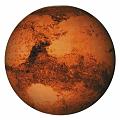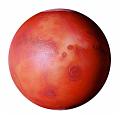MARS APPEARS PALE ORANGE IN THE NIGHT SKY.The Babylonians, Greeks, and Romans all named it after their gods of war. In reality, Mars is a small planet-only half the size of Earth-but there are similarities. Mars, like Earth, has a 24-hour day, polar caps, and an atmosphere. Not surprisingly, Mars has always been the most popular candidate as a site for possible extraterrestrial life. Many scientists believe that some form of life-or at least evidence of past life-may remain within the planet, but no life could survive on the surface. The atmosphere is too thin to block out deadly ultraviolet rays. Mars is also farther from the Sun than Earth, making it much colder. Read some facts about Mars at the bottom, or click here.
Martian Markings
In 1659 the Dutch scientist Christiaan Huygens (1629-1695) drew the first map of Mars, showing a V-shaped mark on the surface that reappeared in the same place every 24 hours. This was Syrtis Major. He concluded, correctly, that its regular appearance indicated the length of the Martian day. The American astronomer, Percival Lowell (1855-1916), made a beautiful series of drawings of the Martian" canals" (above) described by Schiaparelli (see below). Closer inspections showed that these canals were optical illusions caused by the eye's connecting unrelated spots.
Canals on Mars
The Italian astronomer Giovanni Schiaparelli (1835-1910) made a close study of the surface of Mars. In 1877 he noticed a series of dark lines that seemed to form some sort of network. Schiaparelli called them canali, translated as "channels" or" canals." This optical illusion seems to be the origin of the myth that Mars is occupied by a sophisticated race of hydraulic engineers. It was Eugene Antoniadi (p.44) who made the first accurate map of Mars.
Around the Planet Mars
The Martian atmosphere is much thinner than that of Earth and is composed mostly of carbon dioxide. There is enough water vapor for occasional mist, fog, and clouds to form. Manner 9, the first spacecraft to orbit Mars, revealed a series of winding valleys in the Chryse region that could be dried-up river beds. Mars also has large volcanoes. One of them-Olympus Monsis the largest in the solar system. There are also deserts, canyons, and polar ice caps.
Polar Ice
The polar regions of Mars are covered by a thin layer of ice, which is a mixture of frozen water and solid carbon dioxide.This image of the north polar ice cap, taken by ESA's Mars Express spacecraft, shows layers of water ice, dune fields and cliffsalmost 1 mile (2km) high. The polar caps are not constant, but grow and recede with the Martian seasons.
Sampling Rock
In 1997, Pathfinder landed on Mars with a 25-in- (63-cm-) long robot rover called Sojourner. The rover carried special instruments to analyze the composition of Martian rocks.
Testing for Life
The two Viking probes in the 1970s carried out simple experiments on Martian soil. They found no signs of life.
Desert Landscape
Mars resembles a desert. Wmds whip up the red dust and it becomes suspended in the atmosphere, giving the sky a reddish hue. Tomake sure that the Viking images could be reproduced in their proper colors, the spacecraft carried a series of color patches (p.47).Its photographs of these were corrected until the patches were in their known colors, so the scientists could be confident that the landscape colors were also shown correctly.
Problems With The Geocentric Universe
The main problem with the model of an Earth-centered universe was that it did not help to explain the apparently irrational behavior of some of the planets, which sometimes appear to stand still or move backward against the background of the stars (p.19). Early civilizations assumed that these odd movements were signals from the gods, but the Greek philosophers spent centuries trying to develop rational explanations for what they saw. The most popular was the notion of epicycles. The planets moved in small circles (epicycles) on their orbits as they circled Earth.
Martian Moons
Mars has two small moons, Phobos (right) and Deimos, 17 and 10 miles (28 and 16 km) in diameter. Since the orbit of Deimos is only 14,580 miles (23,460 km) from the center of Mars, it will probably be pulled down to the surface with a crash in about 50 million years.
Global Surveyor
Mars Global Surveyor returned thousands of high-resolution images of Mars between 1999 and 2006. It also studied the planet's weather and chemical makeup.
Gullies on Mars
Images sent back by Mars Global Surveyor show these intriguing marks. They are gullies on the wall of a meteor impact crater. It is possible that they formed when the permafrost beneath the surface melted, allowing groundwater up to the surface. They provided evidence for the existence of water on Mars. The ripples at the bottom of the picture are sand dunes.
Facts about Mars
- Sidereal period 687 Earth days
- Surface temperature -184°F to 77°F (-120°C to 25°
- Rotational period 24 hr 37 min
- Mean distance from the Sun141 million miles/230 million km
- Volume (Earth = 1) 0.15
- Mass (Earth = 1) 0.11
- Density (water = 1) 3.95
- Equatorial diameter 4,220 miles/6,790 km
- Number of satellites 2



